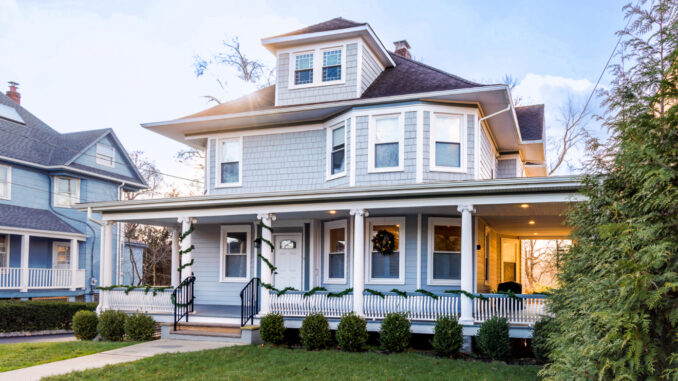
WESTWOOD—Congratulations to Westwood Architect Brian J. Callahan, AIA Callahan Architecture LLC, who was presented with a 2023 Bergen County Historic Preservation Award from the Bergen County Historic Preservation Advisory Board and Bergen County Division of Cultural and Historic Affairs in the category Historic Preservation Project for work at 57 Jefferson Ave. on Thursday, May 4 at Valley Brook Golf Club.
The nomination was submitted by Lauren Letizia and Jackie Martin (former and current chairwomen) on behalf of the Westwood Historic Preservation Commission in March in recognition of Callahan’s partnership with the Historic Preservation Commission and Westwood Planning Board to adhere to regulations of the Jefferson Avenue Historic District while being flexible to modern conditions.
According to the nomination, in 2017 the owner of 57 Jefferson Ave. sought a minor site plan approval to change its use from two residential rental units and one commercial/office to one residential unit and one commercial/office unit.

“As a property within the Jefferson Avenue Historic District, this application triggered a Certificate of Appropriateness review by the Westwood Historic Preservation Commission. The COA was denied by the HPC and the application moved to review by the Westwood Planning Board.
“After much deliberation and lengthy negotiations between the Planning Board, Historic Preservation Commission, and applicant regarding materials, massing, and aesthetics, the application was ultimately approved by the Planning Board with particular requirements for materials and repair/restoration over replacement.”
The result, wrote Letizia, was “an outstanding preservation and restoration project which encapsulated the spirit of the application of the Secretary of the Interior’s Standards for the Treatment of Historic Properties when applied within a local review process.”
She said, “The final project succeeded in masterfully retaining the most defining characteristics of the historic structure, while also allowing the property owner reasonable modern adaptations.”
History of 57 Jefferson Ave., Westwood
Letizia noted that 57 Jefferson Ave. is a colonial revival style foursquare, built c. 1905 as a single family residence. In 2011 it was designated as part of the Jefferson Avenue Historic District for its association with the expansion of Westwood in the late 19th to early 20th century from a small commercial enclave into a commuter railroad suburb.
She said, “Following the introduction of passenger rail service linking Westwood to New York City in 1870, an initial wave of residential development radiated outward from the Westwood train station. The Jefferson Avenue Historic District encapsulates the significant development trajectory 1900–1910 when the Borough’s population increased from 828 to 1,870 residents due largely in part to the increased passenger service, the construction of a water plant (1899), and the introduction of electricity.”
Letizia said, “The homes along Jefferson Avenue were constructed by judge and local real estate investor George T. Brickell and his son, Thomas G. Brickell, director of the First National Bank, mayor of Westwood, postmaster, and town collector, during the first wave of suburban residential development ca. 1890–1905.”
“Before the designation of the district, the majority of homes on Jefferson Avenue were subjected to front, side, and rear additions in order to accommodate single-family expansions, mixed-use, and/or multi-family conversions, but the historic street-scape impression still exists.
“Despite alterations, the cohesiveness of the block is derived from its similarity in bulk (2.5 story frame houses), its irregularity of massing (multiple gable-front dormers and bays), its wraparound porches, and surviving elements including select columns, window and door entablatures, wooden doors, and ribbon windows.
Letizia said, “At the time of designation, 57 Jefferson was the only structure on the block which retained its original wood clapboard siding and semi-circular shingles along three bays and dormers. Exceptional architectural qualities included a hipped roof, wraparound porch supported by fluted Ionic columns, a bowed balustrade, and a pair of ribbon windows with colored glass in the third story dormer.”
Restoration and Preservation
According to Letizia, “The property underwent significant interior renovation and exterior restoration and the result was a well crafted, respectful restoration which maximized the property owner’s use of the structure while also preserving architectural history within the district.”
Most notably, she said, “The massing and design of the porch was retained through a combination of restoration (roof pitch, balustrades, and columns) and replacement (decking and stairs), and the flaring of the exterior walls at the roofline were replicated. Unique windows such as the ones on the third story were fully restored and gutters were appropriately reconstructed.”
Since its completion, several other buildings along Jefferson Avenue have undergone smaller restoration projects (none of which triggered HPC or Planning Board reviews) which have improved the aesthetics and historical impression of the streetscape.
Letizia said, “Beyond its historic and aesthetic value within the Jefferson Avenue Historic District, the restoration of 57 Jefferson was outstanding for the ways in which an applicant’s desires, perceived limitations, and practical needs were considered alongside the impact of historic preservation and restoration for the municipality as a whole.”
She added, “The Westwood Historic Preservation Commission and Planning Board exhibited the nuance that often comes with local interpretation of the Secretary of the Interior’s Standards for the Treatment of Historic Properties in order to best preserve the history of a structure and district, while also addressing immutable realities.”
And she said, “Through its consideration and negotiations, the Commission, Board, and applicant were able to work together to strike a reasonable and conscientious balance that will preserve the history of 57 Jefferson and the Jefferson Avenue historic district for years to come.”
